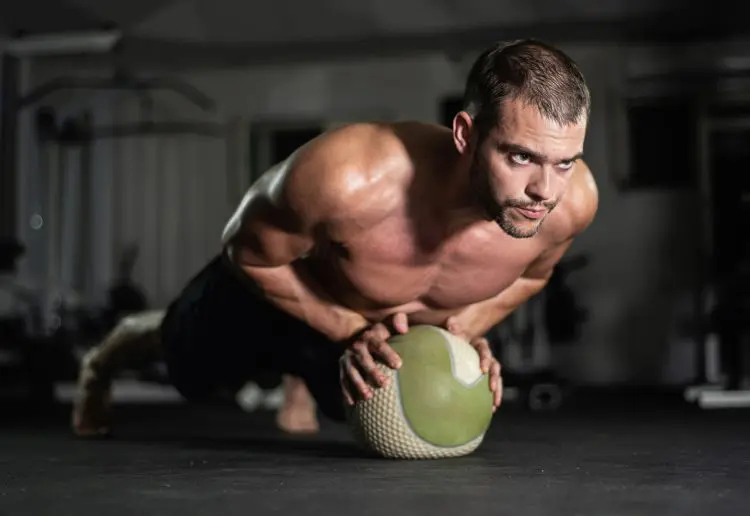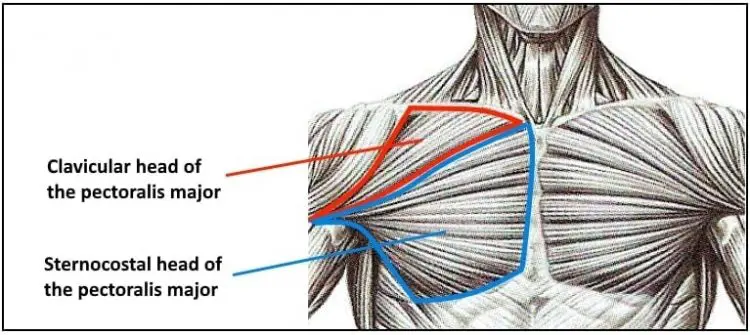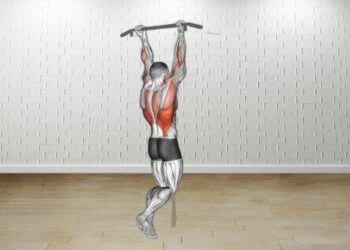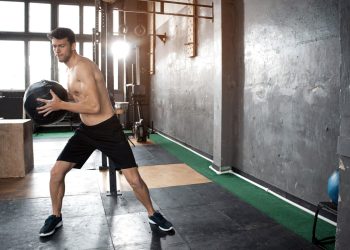Take a look at almost every chest workout, and you’ll usually see bench presses right at the top. The bench press is a hugely popular exercise, and, after all, Monday is National Bench Press Day in pretty much every gym the world over!
While there is no denying the power of the bench press for building muscle and strength, some lifters are bench press non-responders. But, try as they might, these poor people get very little from the bench press.
They may have long arms, narrow shoulders, or shallow chests. But, regardless of the reason, the bench press just doesn’t do much for them.
Others are simply all benched out, having done the same exercise for so many years. While the bench press IS a potent exercise, it can lose some of its benefits if you do it too often or for too long.
The good news is that the bench press is NOT compulsory, and there are plenty of other exercises you can use to pump up your pecs. Good options include push-ups with a weighted vest, wide-grip parallel bar dips, and close-grip dumbbell bench presses.
And now there is another exercise you can add to your library of chest exercises – the dumbbell around the world. This isn’t a great mass builder, but it’ll leave your pecs pumped and sore, so it’s a great chest workout finisher.
Level Up Your Fitness: Join our 💪 strong community in Fitness Volt Newsletter. Get daily inspiration, expert-backed workouts, nutrition tips, the latest in strength sports, and the support you need to reach your goals. Subscribe for free!
We reveal why and how to do dumbbell around the worlds and the best variations and alternatives.
Dumbbell Around the World – Muscles Worked
Although there is quite a lot going on during dumbbell around the worlds, all the movement happens at one joint, which makes this an isolation exercise. The main muscles involved in dumbbell around the worlds are:
Pectoralis major – known as the pecs for short, this is the fan-shaped muscle of your upper chest. There are several sets of fibers that originate from various points on your sternum, clavicles, and superior ribs and insert onto your humerus or upper arm bone. As such, you have an upper, middle, and lower chest, although this is all basically the same muscle.
The actions of the pecs include flexion, horizontal flexion, and medial rotation of the shoulder joint.
Deltoids – these are your primary shoulder muscles. Often called the delts for short, there are three sections or heads to this muscle: anterior or front, medial or middle, and posterior or rear. All three are involved in dumbbell around the world. Still, the anterior is most active, while the other two act as stabilizers.
Biceps – most chest exercises involve the triceps, but this one’s a little different. When doing dumbbell around the worlds, your biceps work with your deltoids to flex your shoulders and keep your arms slightly bent. This isn’t a huge amount of work, but it still means your biceps get an indirect workout from this exercise.
Triceps – located on the back of your upper arm, the triceps must work with your biceps to keep your arms rigid. As with the biceps, this is not a big task, but you may still feel your triceps working.
How to Do Dumbbell Around the World
Get more from dumbbell around the world while keeping your risk of injury to a minimum by following these guidelines:
- With a dumbbell in each hand, lie on a flat exercise bench. Press the weights up, so they’re above your chest, arms slightly bent but rigid.
- Open your arms and lower the dumbbells down until your hands are roughly level with your shoulders. Your palms should be facing upward, i.e., supinated. This is your starting position.
- Without lifting or lowering the weights, sweep them back and up, so they meet above your head. Keep the weights parallel to the floor throughout.
- Next, swing the weights down, so they come together just above your hips.
- Continue sweeping the weights forward and backward for the desired duration or number of reps. Move slowly and deliberately to keep the tension on the target muscles.
Dumbbell Around the World Benefits
Not sure if dumbbell around the worlds deserve a place in your workouts? Consider these benefits and then decide!
- Constant muscle tension – unlike most pec pressing exercises, where tension tends to decrease at the top of each rep, your muscles are constantly contracted during dumbbell around the worlds. This causes occlusion, which is the loss of blood flow into a muscle. Occlusion causes metabolic fatigue and a better pump. However, this is also accompanied by a deep burning sensation. Metabolic fatigue and occlusion are thought to be triggers for muscle growth.
- Increased shoulder mobility – dumbbell around the worlds take your shoulders through an extensive and unusual range of motion. As such, they provide a useful stretch and could help increase joint mobility and muscle flexibility. However, as most people do dumbbell around the worlds to build muscle, this may not be a particularly valuable benefit for most exercisers.
- Low weight, maximum effect – dumbbell around the worlds involve a large range of motion and long levers. Combined with the lengthy time under tension, this means you won’t need to go heavy to get a good workout out of dumbbell around the worlds. As such, this exercise is ideal for home exercisers who may not have access to heavy weights.
- No spotter required – as you’ll be using light weights, and those weights will rarely be held above your face or chest, you can do this exercise safely by yourself. In contrast, it’s never a good idea to do bench presses without a spotter, as failing to complete a rep can cause serious injury.
Dumbbell Around the World Drawbacks
While dumbbell around the worlds are a mostly beneficial exercise, there are also a few drawbacks to consider:
- Not such a good exercise for strength – the dumbbell around the world doesn’t work well with heavy weights. As such, it’s more of an endurance or high-rep hypertrophy exercise and less useful for building brute strength. If you are looking for something like a bench press assistance exercise, you should skip this exercise and look for a move you can do with moderate to heavy loads.
- It could be tough on your shoulders – while the around the world could help improve shoulder mobility and flexibility, if you already have painful shoulders, it could make things worse. For example, the large range of motion could cause extra wear and tear on your shoulder joint, and if you have unstable shoulders, you could end up straining a rotator cuff muscle. For this reason, you MUST go light and monitor your shoulders for discomfort. Skip this exercise if it causes any shoulder pain.
7 Dumbbell Around the World Variations and Alternatives
Dumbbell Around the Worlds are an effective chest exercise, but that doesn’t mean you need to do it all the time. There are variations and several alternatives you can use to keep your workouts productive and interesting:
1. Standing dumbbell around the world
Where regular around the worlds work your chest, this standing variation is all about your deltoids. Like the supine version, this exercise is best done with light dumbbells for medium to high reps, so you get a great burn and pump in the target muscles. It works your anterior and medial deltoids.
How to do it:
Level Up Your Fitness: Join our 💪 strong community in Fitness Volt Newsletter. Get daily inspiration, expert-backed workouts, nutrition tips, the latest in strength sports, and the support you need to reach your goals. Subscribe for free!
- Stand with your feet together and a dumbbell in each hand. Brace your core and pull your shoulders down and back. Rotate your wrists, so your palms are facing forward.
- Raise your arms up and out to the side. Lift your weights until they meet above your head. Remember to keep your arms straight.
- Lower the weights back to the front of your hips and repeat.
2. Dumbbell fly to press
This exercise combines two movements to train your chest in two different ways. Like around the worlds, this exercise doesn’t need a lot of weight to make it effective. Technically, this is a pre-exhaust superset, which is a widely recognized hypertrophy (muscle building) training method.
How to do it:
- Lie on a flat bench with a dumbbell in each hand. Press the weights up and hold them above your chest with your palms turned inward. Bend your elbows slightly but then keep them rigid.
- Open your arms and lower the dumbbells out and down to the side. Squeeze them back up and together. Repeat for the desired number of reps.
- Next, rotate your palms, so they’re facing down your body. Bend your arms and lower the weights down to your armpits. Press them back up and repeat.
- Continue with the presses for the desired number of reps.
- You can also do this exercise with cables, i.e., cable crossovers transitioning into cable presses.
3. Archer push-ups
Archer push-ups are a bodyweight exercise that loads one side of your chest more than the other and also keeps your muscles under constant tension. As such, this is a very useful bodyweight alternative to around the worlds for anyone who prefers bodyweight exercises to training with dumbbells.
How to do it:
- Adopt the push-up position with your hands about 1.5 to 2.0 shoulder-widths apart. Your legs should be straight, core braced, and shoulders pulled down and back.
- Shift your weight over toward one hand and bend that arm. Try to keep the other arm fairly straight. Pivot your hands as necessary to avoid twisting your elbows.
- Descend until your shoulder touches the back of your hand.
- Push yourself back up and return to the center.
- Repeat on the opposite side.
- Continue alternating asides for the duration of your set.
4. Dumbbell squeeze press
The dumbbell squeeze press, also known as the close grip dumbbell press, keeps your chest under constant tension and requires only light to moderate weights to deliver a powerful, pec-pumping workout. While it’s best done using hex dumbbells, any kind of dumbbell can work if you keep them close together.
How to do it:
- Sit on an exercise bench with a dumbbell in each hand. Using a neutral grip, place and press the dumbbells together. Pull your shoulders down and back, and brace your abs.
- Lie flat on the bench and hold the dumbbells on your chest. Press the weights inward as hard as you can. Tuck your upper arms into your sides.
- Push the weights up and over your chest until your arms are straight but not locked. Keep the tension on your pecs by continuing to press the weights together.
- Lower the dumbbells to your chest and repeat.
- Do not ease up on the inward pressure; keep pushing the dumbbells together for the entire duration of your set.
5. Svend press
While we don’t know who Svend is or was, we’re grateful for the constant chest tension exercise that is named after him! You won’t need a lot of weight for this exercise, but even so, you’ll definitely feel it working. This is a great finisher for the end of your regular chest workout.
The Svend press is very similar to the close grip dumbbell press because it also involves pressing two weights together. However, instead of dumbbells, you use weight plates for this exercise.
How to do it:
- With your arms bent, press two five or ten-pound weight plates together in front of your chest.
- Push the plates away from you until your arms are straight. Simultaneously press your arms inward, squeezing the plates together.
- Bend your arms and pull the plates back toward your chest, and repeat for the desired number of reps.
- Svend presses can be done standing or lying on a bench or the floor. If you do the lying version, take extra care not to drop the plates on your chest or face.
6. Medicine ball push-up
Doing push-ups with your hands on a medicine ball force you to press your hands together, increasing chest muscle activation. This is a challenging progression from push-ups with your hands on the floor but a very effective chest hypertrophy exercise. Bend your legs and rest on your knees if you cannot do this exercise with good form.

How to do it:
- Put your medicine ball on the floor in front of your feet. Squat down and place your hands on either side of the apex of the ball.
- Keeping your arms straight, walk your feet out and back into the push-up position. Brace your core.
- Bend your arms and lower your chest to the ball.
- Extend your arms and repeat.
- Make this exercise more challenging by wearing a weighted vest or elevating your feet.
7. Dumbbell/cable bench press combo
While the setup for this exercise is a little convoluted, it will generate a lot of tension in your pecs. As you press the weights up, the tension from the cables is trying to pull your arms apart, so you’ll have to work extra hard to overcome resistance from two directions at the same time. This all adds up to one of the most demanding chest exercises around!
How to do it:
- Place an exercise bench in the middle of a cable crossover machine. Attach straps to the low cables and put the straps around your wrists. Hold a dumbbell in each hand and lie down.
- Lower the dumbbells to your shoulders and then press them upward and inward. The cables will try to pull your arms apart; don’t let them.
- Lower the dumbbells to your shoulders and repeat.
- This tricky exercise is probably best done with a spotter on hand. You can do this move on a flat, incline, or decline bench as required.
Dumbbell Around the Worlds – Wrapping Up
Exercise variation is the key to interesting and productive workouts. Once you start to get bored of your training, you’ll not only lose motivation, but your workout will cease to be as productive.
That’s why no one-size-fits-all training program exists – even the best workout will stop working once you become accustomed to it.
So, avoid training ruts by making small changes to your workout week by week and more significant changes every couple of months. This includes adding new and unusual exercises to your training from time to time.
The dumbbell around the world hits your chest from an unusual angle, uses a large range of motion, and creates a lot of muscle tension with light weights. As such, it’s a valuable addition to your pec workout library.
Try it; you’re gonna like it!
Interested in measuring your progress? Check out our strength standards for Bench Press, Push Ups, Dumbbell Bench Press, and more.









